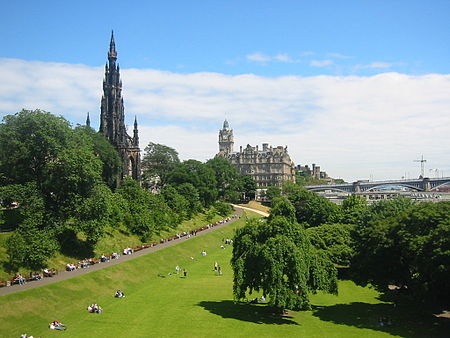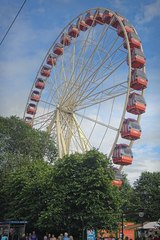Princes Street Gardens

Princes Street Gardens are two adjacent public parks in the centre of Edinburgh, Midlothian, lying in the shadow of Edinburgh Castle. The Gardens were created in the 1820s following the long drainage of the fœtid Nor Loch and building of the New Town, beginning in the 1760s.
The North Loch or Nor Loch lay on the north side of the town: it was originally an artificial creation forming part of its mediæval defences, and it made the expansion of the city northwards difficult. The water was habitually polluted from sewage draining downhill from the Old Town. When it was drained for the creation of the Georgian New Town, the steep valley in which it lay remained, and had to be bridged by the new North Bridge, and in this valley the gardens were created.
The gardens run along the south side of Princes Street and are divided by The Mound, on which the National Gallery of Scotland and the Royal Scottish Academy buildings stand. East Princes Street Gardens run from The Mound to Waverley Bridge, and cover eight and a half acres. The larger West Princes Street Gardens cover twenty-nine acre and extend to the adjacent churches of St John the Evangelist and St Cuthbert's, near Lothian Road in the west.
In 1846 the railway was built in the valley to connect the Edinburgh-Glasgow line at Haymarket with the new northern terminus of the North British line from Berwick-upon-Tweed at Waverley Station.[1]
The Gardens are the best known parks in Edinburgh, having the highest awareness and visitor figures for both residents and visitors to the city.[2]
Railway

In 1846, the Edinburgh and Glasgow Railway company constructed a sunken railway line along the southern edge of the Gardens to join its Haymarket terminus to a new General Station adjoining the North British Railway Company's North Bridge terminus (both stations later renamed 'Waverley'). This involved constructing the Haymarket Tunnel (comprising separate north and south tunnels), 910 metres long, between the western end of the gardens and Haymarket Station. A shorter tunnel (again comprising two separate tunnels) was also dug through The Mound, dividing the East and West Gardens.
East Princes Street Gardens
History

East Princes Street Gardens originated after a dispute between the Edinburgh Corporation and the early New Town proprietors, among whom was the philosopher David Hume who resided in St. David Street, a side street off Princes Street. In 1771 the Corporation acquired the land as part of the First New Town development. It began feuing ground on the south side of Princes Street (on the site of the current Balmoral Hotel and Waverley Mall) for the building of houses and workshops for a coach-builder and a furniture-maker. After a failed petition to the Corporation, the proprietors raised two actions in the Court of Session to halt the building and to condemn the Corporation for having contravened their feuing terms by which they had pre-supposed open ground and a vista south of the street. After the Court found in favour of the city's Corporation on the first point, the decision was quickly appealed to the House of Lords and overturned, but when the Court again supported the council on the second point, the matter was submitted to judicial arbitration. This resulted in a judgement that the houses could be completed which later allowed the North British Hotel (Balmoral Hotel) to be built on the site, that the adjacent furniture-maker's premises must not rise above the level of Princes Street (which is the reason the roof of the Waverley Mall is at street level) and that the ground westwards for half the length of Princes Street "shall be kept and preserved in perpetuity as pleasure-grounds to be dressed up at the expense of the town council as soon as may be."[3]
Monuments
@

Along the south side of Princes Street are many statues and monuments. In the East Gardens most prominent is the Scott Monument, a Neo-Gothic spire built in 1844 to honour Sir Walter Scott. Within East Princes Street Gardens there are statues of the explorer David Livingstone, the publisher and Lord Provost Adam Black and the essayist Professor John Wilson, who wrote under the pseudonym Christopher North. There is also a small commemorative stone honouring the volunteers from the Lothians and Fife who fought in the Spanish Civil War.
Winter Wonderland
Every year, in the weeks leading up to Christmas, the East Gardens are transformed with a variety of amusement park rides and the Christmas Market, which has food and gifts from all around the world. The most notable attractions are the ice rink and the 108-foot high Ferris wheel, often dubbed 'The Edinburgh Eye'.
Pictures
-
Princes Street and the gardens in 2010
-
Sir Walter Scott, Scott Monument
-
Statue of Adam Black
-
Statue of David Livingstone
-
East Princes Street Gardens
-
East End of Princes Street Gardens
-
The Christmas Market in 2012
West Princes Street Gardens
Early history

West Princes Street Gardens were originally the private property of "the Princes Street Proprietors" who overlooked them from their houses on the western half of the street. This was passed to them from the council in 1816[4] and the gardens were opened to subscribers generally in the New Town in 1821.
Dogs, cricket, perambulators and smoking were prohibited under their rules, and people using bath-chairs had to present a doctor's certificate to the Committee of the garden attesting to their ailment not being contagious. An application by the Scottish Association for Suppressing Drunkenness that the gardens be opened during Christmas and New Year "with the object of keeping parties out of the dram shops (which is to say illegal drinking premises)" led eventually to their being opened to the general public on Christmas Day, New Year's Day and one other day in the year.
Public park
@

In 1876, despite much opposition from residents, the town council reacquired the ground for use as a public park. The new park was laid out by the City Architect Robert Morham including the building of a very picturesque gardener's cottage at the east end of the West Gardens. As part of a later agreement (c.1880) the council widened Princes Street (resulting in a far steeper embankment on that side). A series of statues were erected along the edge of the widened road.
Modernization of the gardens is currently under discussion with the launch of The Quaich Project fundraising campaign from the Ross Development Trust. The new design will improve accessibility and provide new pathways and connections across the city.[5]
Shelters
In 1939 four huge air-raid shelters were created within this northern embankment. The distinctive shelters now on the upper walkway date from 1950 and were designed by Alexander Garden Forgie. As with most structures in the gardens they are listed buildings.[6]
Ross Bandstand and Ross Fountain

The Ross Bandstand in the centre of the West Gardens is named after William Henry Ross, Chairman of the Distillers Company Ltd., who gifted the first bandstand on the site in 1877. The present building and terraces date from 1935.

The Princes Street proprietors contributed £500 as a goodwill gesture to the cost of the bandstand.[7] Various concerts and other events are held at the Ross Bandstand including the Edinburgh Festival's Fireworks Concert, Men's Health Survival of the Fittest, and during the city's Hogmanay celebrations. The Ross Development Trust proposed to rebuild the bandstand as a Ross Pavilion based on design by architects wHY following an international competition in 2017.[8]
The Ross Fountain is the focus of the western end of the gardens. Gifted by Edinburgh gunsmith Daniel Ross, it was originally installed in 1872 and restored in 2018 with the help of the Ross Development Trust.
Monuments

Along the south side of Princes Street are statues of the poet Allan Ramsay, the church reformer Thomas Guthrie, and the obstetric pioneer James Young Simpson. Other monuments are the Royal Scots Greys Memorial,[9] the Scottish American War Memorial, the Norwegian Brigade War Memorial, and Wojtek the Bear.
The statuary group on the lower path represents The Genius of Architecture crowning the Theory and Practice of Art and is by William Brodie originally for the garden of Rockville, the home of his maverick architect son-in-law Sir James Gowans. It was moved here in the 1960s following the demolition of Rockville.

A Swedish runestone known as the Princes Street Gardens Runestone was located beneath the Castle walls, but due to security concerns it was removed from its location in November 2017 and was moved to George Square, outside the school of Scandinavian studies in 2020.[10]
At the eastern entrance to the Gardens there is the world's first floral clock dating from 1903.
Royal Scots Monument
The large curved monument to the Royal Scots stands slightly hidden just south of the gardener’s cottage. It was designed by Sir Frank Mears with sculpture by Pilkington Jackson. Described as a "modern henge" it dates from 1950 but was added to and "finalised" in May 2007 following the termination of the Royal Scots in 2006. This added additional Battle Honours gained since the 1950s.
Pictures
-
West Princes Street Gardens in 1875
-
West Princes Street Gardens from the Castle slopes
-
The Floral Clock
-
The Gardener's Cottage
-
Wojtek the bear statue
-
West Princes Street Gardens in 2013
-
Switching on the restored Ross Fountain, 2018
-
The Ross Fountain
-
Allan Ramsay statue
-
The Genius of Architecture crowning the Theory and Practice of Art
-
Royal Scots Greys Memorial
-
Scottish-American War Memorial
-
Norwegian Brigade Stone
-
James Young Simpson statue
-
Statue of Thomas Guthrie
-
Memorial to Robert Louis Stevenson
-
Amphitheatre of the Ross Bandstand, Edinburgh
Location
- Location map: 55°57’0"N, 3°12’11"W
Outside links
| ("Wikimedia Commons" has material about Princes Street Gardens) |
- Bartholomew's Chronological Map of Edinburgh (1919)
- Ross Development Trust
- History of Ross Fountain
- Edinburgh air raid shelter in West Princes Street Gardens
References
- ↑ E F Catford, Edinburgh, The story of a city, Hutchinson 1975, p.209, ISBN 0 09 123850 1
- ↑ "Edinburgh Park and Garden Strategy p.20" (PDF). http://www.edinburgh.gov.uk/download/downloads/id/4292/edinburgh_public_park_and_gardens_strategy.
- ↑ E F Catford, Edinburgh, The story of a city, Hutchinson 1975, pp.115-6, ISBN 0 09 123850 1
- ↑ Buildings of Scotland:Edinburgh by McWilliam Gifford and Walker
- ↑ The Quaich Project
- ↑ Edinburgh's Post-War Listed Buildings ISBN 978-1-84917-050-5
- ↑ E F Catford, Edinburgh, The story of a city, Hutchinson 1975, pp.209ff, ISBN 0 09 123850 1
- ↑ £25m plan to replace Edinburgh bandstand in turmoil, The Scotsman, 11 December 2017
- ↑ City of Edinburgh, The Royal Scots Greys Monument
- ↑ "Edinburgh’s forgotten Viking stone to get new home". https://www.scotsman.com/lifestyle/edinburgh-s-forgotten-viking-stone-to-get-new-home-1-4613517.
























